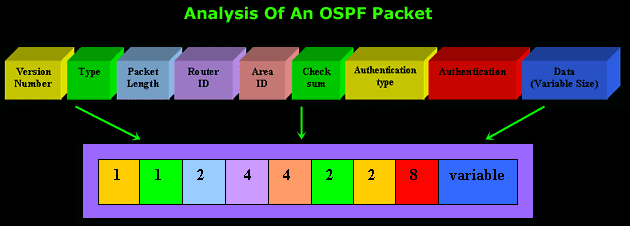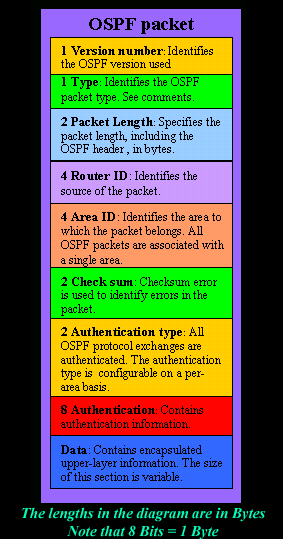Open Shortest Path
First (OSPF) Routing Protocol
Introduction
Open Shortest Path First (OSPF)
is a routing protocol developed for Internet Protocol
(IP) networks by the interior gateway protocol (IGP)
working group of the Internet Engineering Task Force (IETF).
The working group was formed in 1988 to design an IGP
based on the shortest path first (SPF) algorithm for use
in the Internet. Similar to the Interior Gateway Routing
Protocol (IGRP), OSPF was
created because in the mid-1980s, the
Routing Information Protocol
(RIP) was increasingly
unable to serve large, heterogeneous internetworks.
OSPF is a
classless routing
protocol, which means that in its updates, it includes
the subnet of each route it knows about, thus, enabling
variable-length subnet masks. With variable-length
subnet masks, an IP network can be broken into many
subnets of various sizes. This provides network
administrators with extra network-configuration
flexibility.These updates are multicasts at specific
addresses (224.0.0.5 and
224.0.0.6).
The
cool
3D diagram below shows us the information that
each field of an OSPF packet contains:


Analysis Of "Type" Field
All
OSPF packets begin with a
24-byte header, which is shown right above. There
is however one field I would like to give a bit more
attention to, and this is the "Type"
field which is 1 byte long.
As
illustrated in the diagram, the "Type"
field identifies the OSPF
packet type as one of the following:
-
Hello: Establishes and
maintains neighbor relationships.
-
Database Description:
Describes the contents of the topological database.
These messages are exchanged when an adjacency is
initialized.
-
Link-state Request:
Requests pieces of the topological database from
neighbor routers. These messages are exchanged after
a router discovers (by examining
database-description packets) that parts of its
topological database are out of date.
-
Link-state Update:
Responds to a link-state
request packet. These messages also are used
for the regular dispersal of
Link-State Acknowledgments (LSA).
Several LSAs can be
included within a single
link-state update packet.
-
Link-state Acknowledgment:
Acknowledges link-state update
packets.
OSPF has two primary
characteristics:
1)
The protocol is open (non
proprietary), which means that its specification is in
the public domain. The OSPF
specification is published as Request For Comments (RFC)
1247.
2) The
second principal characteristic is that
OSPF is based on the SPF
algorithm, which sometimes is referred to as the
Dijkstra algorithm, named for the person credited with
its creation.
OSPF is a
Link State
routing protocol that calls for the sending of
link-state advertisements (LSAs) to all other routers
within the same hierarchical area. Information on
attached interfaces, metrics used, and other variables
is included in OSPF LSAs.
As OSPF routers accumulate link-state information, they
use the SPF algorithm to calculate the shortest path to
each node.
As a
Link State routing
protocol, OSPF contrasts
with RIP and
IGRP, which are
Distance Vector routing
protocols. Routers running the
Distance Vector algorithm send all or a portion
of their routing tables in routing-update messages to
their neighbors.
Additional
OSPF features include
equal-cost, multipath routing, and routing based on
upper-layer type-of-service
(TOS) requests.
TOS-based routing supports
those upper-layer protocols that can specify particular
types of service. An application, for example, might
specify that certain data is urgent. If
OSPF has high-priority
links at its disposal, these can be used to transport
the urgent datagram.
OSPF supports one or more
metrics. If only one metric is used, it is considered to
be arbitrary, and TOS is
not supported. If more than one metric is used,
TOS is optionally supported
through the use of a separate metric (and, therefore, a
separate routing table) for each of the eight
combinations created by the three IP
TOS bits (the delay,
throughput, and reliability bits). If, for example, the
IP TOS bits specify low
delay, low throughput, and high reliability, OSPF
calculates routes to all destinations based on this
TOS designation.
|
